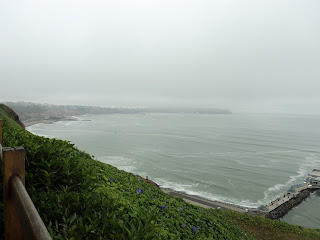So, a brief rundown as to what we did in Bolivia. We arrived in La Paz which is an extremely busy and bustling city. I really liked it because it was what I had always envisioned a South American city to be like: a mix of cosmopolitanism and indigenous cultures. There were so many outdoor markets to explore and people sold the most random things! For example, one lady might have a stand selling batteries, socks, shampoo, and barrettes. Another person might sell old wires, old shoes, and toilet paper. It was just so fascinating to see all the random stands mixed together and to think how no one would ever sell, let alone buy, such random things from a stand on the street in the U.S. I also went to an amazing art museum, ate some delicious saltenas (kind of like an empanada but in my opinion, better), and walked all around.
La Paz
After La Paz, we headed south to Potosi, a mining town in Bolivia, which is possibly one of the most interesting places I have been, as the culture and beliefs of the townspeople are so incredibly unique. We did a tour of a mine, which our guidebook warned us to be somewhat dangerous as we would inhale dust and fumes, be far underground, and experience extreme temperature changes. Although I was definitely very nervous, I wanted to see in what conditions the miners worked, and let me tell you, mining would be the job from hell.
So, before we entered the mine, we went to the miner's market to buy some gifts for the miners. It is a custom that tourists should offer gifts to the miners since their work conditions are so rough. We bought some juice and coca leaves (leaves from the coca plant--same plant from which cocaine is made-- that Bolivians chew incessantly to curb their appetite and keep them awake) and that was it. We couldn't bring food, and although the miners are underground for upwards of 10hours, they are not able to eat as it is PROHIBITED to go to the bathroom (number 2...) within the mine so they cannot even risk it by eating. I just cannot even imagine being underground in the dark, breathing in dust, hungry, working tirelessly for hours.
We entered the mine dressed as miners and were told that before we entered, we should take a shot of pure alcohol, 100% proof, and give a shot to the pacha mama (mother earth) so that she would take care of us while underground. This is what the miners do everyday. As it was 8am and I don't enjoy shots, I opted to take the risk that the pacha mama might not care for me...
 |
| Our mining gear, head lamps and all! |
Side note: Women are not allowed to be miners as the belief is that if a woman is underground working, the pacha mama would become jealous of the Tio, the god Bolivians believe to be the controller of the underground. So, miners are typically boys/men between the ages of 15 and 40 or so. Every time I saw a teenager working in such conditions, I couldn't help thinking what my brothers were doing at that very moment and how incredibly fortunate they are that they will never have to have such a grueling, depressing job.
 |
| Kevin crawling through the mine |
After Potosi, we continued south to Tupiza which is a tiny little town from where we would begin our journey called the Southwest Circuit. This circuit is a 4day trip in a 4x4 through the desert of Bolivia passing lagoons, geysers, mountains, hot springs, and finally arriving at the famous salt flats. Kevin, a couple from Sweden, and a French guy, and I all piled into a jeep with our driver and cook. It was amazing to see so many different elements of nature...things I never even knew existed or could never even picture. We would drive all day, everyday making brief stops to take in the sights. We would sleep in different little towns, some of which only had 12 inhabitants or so. It felt like another world.
Salvador Dali rocks
A lagoon in the middle of the desert
When we arrived to the salt flats, it was the most amazing sight. We went to see the sunset and it was as if the sun was setting over a white ocean.
On the salt flat before the sunset
In summary, Bolivia was a mix of observing depressing living and work conditions and seeing unbelievable natural beauty.A truly unique experience.
I promise to post about Chile and Argentina this week before I come home May 16!

















